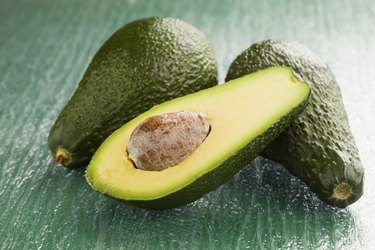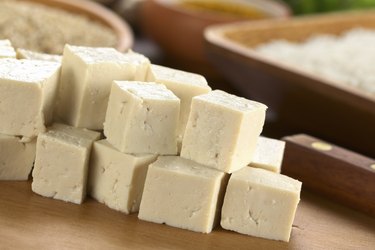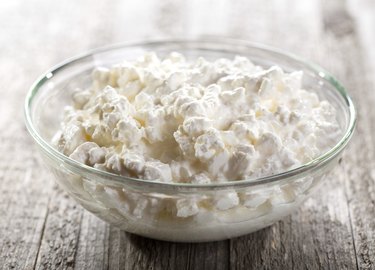
Soft foods help elderly people who have difficulty chewing or swallowing continue to eat balanced, nutritious meals. Doctors also may recommend softer foods following head, neck or abdominal surgery, and for patients undergoing treatments such as chemotherapy or radiation. Tender or soft foods help ease the amount of chewing and swallowing needed to ingest food. You can also modify tougher foods in texture and consistency for better tolerance.
Grains
Video of the Day

Start your day with soft breakfast grains such as toast or low-fat muffins. Other healthy choices include cold cereal with milk and cooked cereal, such as oatmeal or cream of wheat. Cooked pasta, noodles and rice are versatile grains you can add to casseroles, stews and soups. Skip hard-to-chew grains such as hard rolls, bread sticks, bagels, taco shells and popcorn. Drugs.com also recommends avoiding coarse or dry whole grains and French, sourdough, rye and pumpernickel breads.
Video of the Day
Fruits and Vegetables

Fill your diet with softer fresh fruit selections such as bananas, avocados, cut-up melon, fresh berries and ripe peaches. Canned fruit, like pears, mandarin oranges, fruit cocktail and applesauce are other smart options, but choose those packed in their own juice or with no added sugar. Load up on well-cooked, pureed or mashed vegetables such as carrots or squash, finely chopped green beans and vegetable juice. Fresh tomatoes, lettuce and mashed, baked or boiled potatoes are also easy-to-chew selections. Limit consumption of raw fruits and vegetables with a tough skin or membrane, such as apples, pineapple, celery, whole kernel corn, coconut and dried fruit.
Protein

Choose lean and tender meats, such as lean ground or top round beef, poultry and pork loin. Other options include soft fish without bones, tofu and creamy peanut butter. Poached, boiled or scrambled eggs and mashed legumes are also easy-to-chew choices. Ease the amount of chewing needed by limiting fried and crispy meats, beef jerky, sausage, nuts and seeds.
Dairy

Most dairy selections are nutrient-dense and naturally easy to chew. Enjoy low-fat milk or cottage cheese and reduced-fat shredded or sliced cheese. Reach for low-fat plain yogurt or light yogurt, but skip the crunchy granola.
Extras

Incorporate small amounts of solid fats, like butter, margarine, mayonnaise and sour cream, to add moistness and flavor to your foods. Finish your meal with a light and healthy softer dessert. Angel food cake, fruit ice, yogurt parfaits and peaches with low- or fat-free vanilla ice cream are all smart choices. Avoid hard-to-chew extras, such as dried fruit, hard candies, potato chips, snack chips and crispy bacon.
Tips and Considerations

Make meal preparation easier by using a food processor to alter the consistency of tough foods. You can also chop, steam, stew, grind or grate hard or tough foods without sacrificing their nutritional value, says Colorado State University Extension. Add chicken, beef or vegetable broth, and conservative amounts of gravy or sauces to help moisten foods. Eating smaller, more frequent meals and snacks can also help when it is difficult to chew, suggests the University of Michigan Hospital and Health Center. Focus on nutrient-dense snacks to ensure you are meeting your nutritional needs. Remember to consult your physician or health-care provider prior to any new dietary regimen to ensure it is a safe and effective choice for you.
- Colorado State University Extension: Nutrition and Aging
- National Heart, Lung and Blood Institute: Healthy, Tasty Desserts
- Drugs.com: Soft Diet
- Jackson Siegelbaum Gastroenterology: Soft and Mechanical Soft Diet
- University of Michigan Hospital and Health Centers: Meal Planning for Mechanical Soft Diet
- National Institute of Health Senior Health: Eating Well As You Get Older
- National Institute on Aging: Healthy Eating After 50
- Helpguide.org: Senior Nutrition
- Agingcare.com: Ten Reasons Why Your Aging Parent May Not Be Eating Properly